More like this
How do I Show or follow a channel in Office 365 Microsoft Teams?
How do I access an Office 365 shared/generic mailbox on iOS (iPhone/iPad)?
How do I remove the "Birthdays" calendar from my office 365 calender?
Recover deleted items or email in Outlook Web App
When you accidentally delete an item from your mailbox, you can often recover it. The first place to look for a deleted item, such as an email message, calendar appointment, contact, or task is the Deleted Items folder. If it's not there, you might still be able to recover it by using Recover deleted items,
If you can't find an item in the Deleted Items folder, the next place to look is the Recoverable Items folder.
To recover items from the Recoverable Items folder:
In a web browser, sign in to Outlook Web App Go to https://www.southampton.ac.uk/365/
The email address you enter should be in the following format: username@soton.ac.uk
In your email folder list, right-click Deleted Items, then select Recover deleted items.
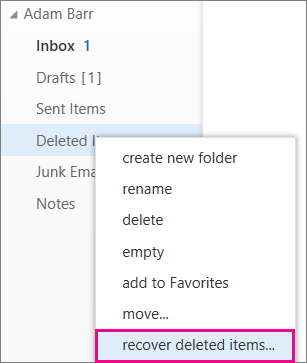
If necessary, use the search box to find the item you want to recover.
When you find the item, select it, and then select Recover.
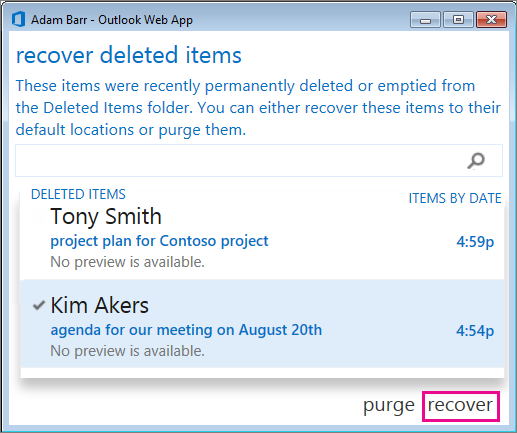
Recovered items are moved to the default location for each item type.
- Messages go to your Inbox
- Calendar items go to your Calendar.
- Contacts go to your Contacts folder.
- Tasks go to your Tasks folder.
Tips for recovering items in your Recoverable Items folder
- The deleted date for an item in the Recoverable Items folder is when the item was moved to the Deleted Items folder. It's not the date the item was moved to the Recoverable Items folder.
- If you have a lot of items in the Recoverable Items folder, it might be hard to find what you're looking for because items don't have icons, and they all look very similar.
- If you're looking for a contact, look for an item that has the name of the person, but not subject line.
- If you're looking for a calendar appointment, look for an item that doesn't have a person's name or a subject line.
- If you're looking for a contact, calendar appointment, or a task look for the text, No preview is available.
- To recover multiple items, hover over each item and select the checkbox next to it, select Recover.
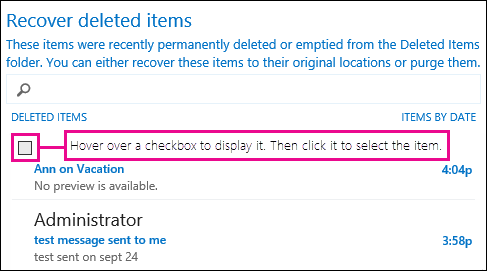
You can also recover multiple adjacent items by selecting the checkbox for first item, holding down the Shift key, and then selecting the checkbox for the last item. When all items are selected, select Recover.
You can purge items from the Recover deleted items list. Just select the item and then select Purge. If you purge an item, you won't be able to use Recover deleted items to get it back. Purging a message won't remove it from any backups that were made before you purged it.
Recover deleted items in Outlook for Windows
Make sure Home is selected at the top, left-hand corner, and then click Recover Deleted Items From Server.
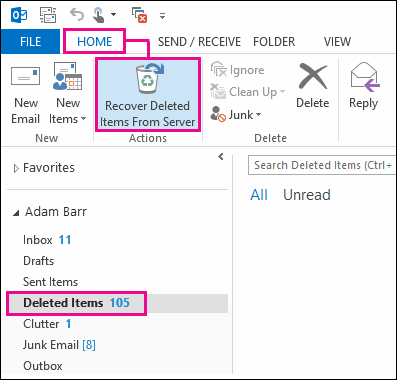
Important: If Recover Deleted Items From Server isn't there, your account doesn't support recovering an item that's no longer in your Deleted Items folder.
Select the item you want to recover, click Restore Selected Items, and then click OK.
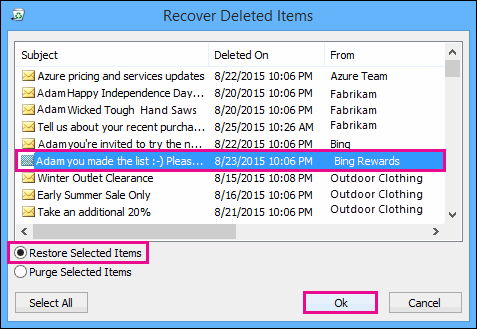
Where do recovered items go?
When you recover items from the Recoverable Items folder, they are moved to the Deleted Items folder. So after you recover an item, you can find it in your Deleted Items folder and then move it to another folder.
Additional resources to help you make the most of Office 365
Was this article helpful?
If you have any further comments, please put them below.
Please note that feedback is anonymous - if you require a reply or assistance, please raise a ticket via ServiceLine.
Thank you for your feedback, it is much appreciated.